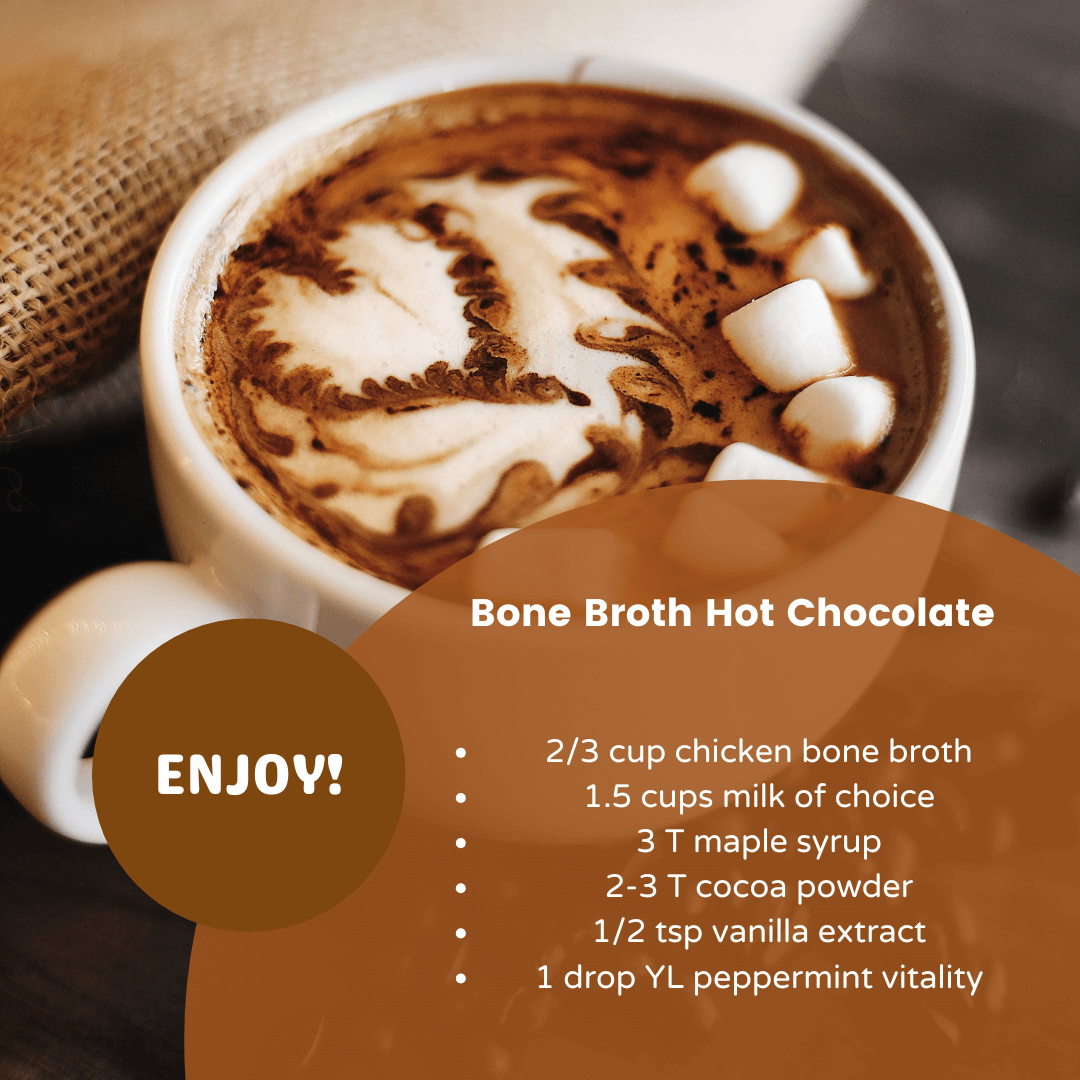Winter's chill brings with it the perfect excuse to indulge in comforting beverages, and what could be more soothing than a cup of gut-healing hot chocolate? Made with nutrient-dense bone broth, this recipe combines the richness of chocolate with the health benefits of bone broth, creating a drink that's both delicious and nutritious. Ready in just under five minutes, it's an ideal treat for the entire family to enjoy during the cold months.
The secret to this hot chocolate's appeal lies in its simple yet effective ingredients: bone broth, milk, maple syrup, cocoa powder, vanilla extract, and a hint of cinnamon. For an extra touch of indulgence, a drop of Young Living's Peppermint Vitality essential oil can be added to enhance the flavor. Whether topped with marshmallows or whipped cream, this hot chocolate is a delightful way to incorporate the healing properties of bone broth into your daily routine.

Instructions
- Heat: In a medium saucepan over medium heat, bring the bone broth to a light simmer.
- Mix: Add the milk, maple syrup, cocoa powder, vanilla extract, and cinnamon to the saucepan and whisk until creamy.
- Serve: Pour the hot chocolate into two separate mugs. If desired, use a milk frother to make the hot chocolate nice and foamy (this is where I also like to add a drop of peppermint vitality. Serve with optional marshmallows or whipped cream on top. Sip and enjoy!
Notes:
- I recommend using a chicken bone broth for this recipe without a ton of added herbs or seasoning.
- You can add 1 scoop of collagen to the hot chocolate if desired. Just whisk it into the hot chocolate in the saucepan before serving.
- You can swap the maple syrup for honey, however it will be slightly sweeter.
- Add more cocoa powder to taste if you like it extra chocolatey.
- Want to make a single serving? Just cut the recipe in half!
As someone who has been sipping on bone broth for over a decade, I’m always looking for new ways to incorporate it into my routine. Bone broth is rich in collagen, minerals, and protein, so it’s a great way to boost the nutrient density of recipes. I love making my own bone broth and using it in soups, stews, and even in making rice instead of using water.
I first came across the idea of making hot chocolate from bone broth from a brilliant internet friend, Fallon Lee. After seeing the idea, I started experimenting with it for my own family. My kids absolutely love hot chocolate, especially during the cold weather months. And if I could actually disguise bone broth in a chocolatey drink for them? Well, sign me up!
After months of perfecting it, I’m happy to share that my rather picky kids absolutely love my bone broth hot chocolate recipe! It’s creamy and rich, and the combo of vanilla, cinnamon and peppermint adds the perfect amount of warmth. If you’re not a huge fan of bone broth but want to soak up the benefits, this recipes is right up your alley! It makes two servings so you can share a cup with your children, or save some for the next day!
Broth vs Bone Broth
While broth and bone broth are often used interchangeably, there are some distinct differences between the two. Broth is made by simmering meat and vegetables in water. It's typically seasoned with salt and may include herbs and spices for flavor.
Bone broth, on the other hand, is a further evolution of broth and stocks. It’s made by simmering vegetables, meat, and bones, often with connective tissues like ligaments and tendons. The bones are usually simmered for a longer period, sometimes up to 24 hours. As a result, bone broth is rich in minerals, amino acids, and collagen, and has a higher protein content in comparison to broth.
Let me know if you try this and what you think! Enjoy!
Melinda

Is protein YOUR missing piece? Research shows most women aren't eating enough. When working with clients, I found many women were eating 50 grams a day OR LESS! This isn't ANYWHERE NEAR ENOUGH!
Why is protein important?
1. Protein is broken down into amino acids, which are the building blocks for organs, hormones, enzymes, and even antibodies.
2. Protein is necessary to build and rebuild muscle. If you want to add or even maintaintle muscle mass, you need to eat sufficient protein.
3. Protein has a stabilizing effect on blood sugar, especially when consumed at breakfast. It reduces jitteriness, agitation, and mood swings, and improves sleep.
4. It helps with feeling full and satisfied.
5. It prevents muscle wasting. Higher protein diets can benefit both older adults and people who suffer from chronic illness who are susceptible to muscle wasting.
Even with a moderately low protein intake, your body will start showing subtle signs that it isn't getting enough. Here are the major ones:
1. You get sick regularly. Lack of sufficient protein takes its toll on your immune system. Studies show even marginally low protein intake may impair immune function and your body's ability to fight infections like colds and flu.
2. Hangry/shaky between meals. Protein helps stabilize blood sugar by blunting the absorption of carbohydrates. This leads to beneficial changes in metabolic, cardiovascular and inflammatory markers. It also improves satiety, which means you feel less hungry and cranky in between meals.
3. Thinning hair and brittle nails. Hair, skin, and nails are largely made of protein, specifically collagen and keratin. If you lack these proteins, you may start noticing dry, flay skin, ridges on your fingernails, and thinning hair. This product has also helped tremendously with my hair, skin and nails: https://m.lfstps.com/lv213/CHw3X
Sulfer-Containing amino acids influence our ability to detox, and combat free radicals and DNA damage.
4. Exhaustion or lasting soreness after exercise. Slow recovery and muscle repair after exercise is a key sign of inadequate protein intake. Minor injuries or pain that would otherwise resolve quickly can stick around for much longer if you're not getting enough protein.
5. Weakness or chronic fatigue. If you feel weak, lethargic, or tired all the time, this is a classic sign of poor of low protein intake. It's usually coupled with an inability to stay warm.
6. Low Libido. While often normalized for women, a loss of libido can be an indication your body is deficient in protein! Low protein intake causes low testosterone levels, which causes a decline in sexual function, muscle tissue, and red blood cells. Women...it's time to eat!
So how do you make sure you're getting enough?
Include high quality protein at each meal and as a snack when possible. Focus on foods high in bioavailable protein, essential amino acids, and sulfur-containing amino acids. These foods are also rich in fat-soluable vitamins (necessary for bone health), B Vitamins, and heme iron. Heme iron is the form of iron that is digestible to the human body. Lastly, fat soluble itamins help minerals deposit into bones and teeth! Poor bone density and reoccurring dental issues (root canals, cavities, etc) are a sign of too low fat soluble vitamins and low quality protein intake.
- pasture raised eggs
- chicken
- beef
- whole milk
- collagen (Young Living, Perfect Supplements, PaleoValley, Garden of Life) are some of my favorite sources
- shrimp
- salmon'
- bone broth
- duck
- turkey
- yogurt
- cheese
- jerky (I love PaleoValley)
- lamb
- sausage
- gelatin gummies
Example Protein in a Day
Breakfast
- 2 eggs = 12g
- 1 scoop collage = 6 g
- Lunch
- 4 oz salmon = 24g
- Dinner
- 4 oz ground beef = 20g
- Snacks
- 2 cheese sticks = 10g
- 1 cup bone broth = 10g
- 1 cup yogurt = 24g
- Do you struggle to get enough protein? What are your favorite sources?
I hope this was helpful! If you want a list of good quality protein sources or even a handful of quick breakfast ideas, let me know. I'll send them over!- Blessings (and I don't know why it got stuck on the bullet points. Obviously very human here. LOL
- Melinda Haak


